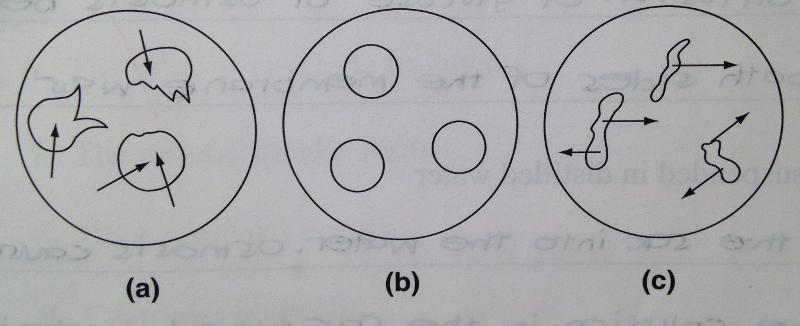Instructions for Side by Side Printing
- Print the notecards
- Fold each page in half along the solid vertical line
- Cut out the notecards by cutting along each horizontal dotted line
- Optional: Glue, tape or staple the ends of each notecard together
Exercise 5 The Cell: Transport Mechanism and Permeability
front 1 Molecular Motion | back 1 - reflects the kinetic energy of molecules - is random and erratic |
front 2 Velocity of molecular movement | back 2 - is lower in larger molecules - increases with increasing temperature |
front 3 Sac 1: 40% glucose suspended in distilled water | back 3 Glucose diffused from the sac into the water; using the Benedict’s test indicated the presence of the glucose that passed through the membrane. Water moved into the sac by osmosis; sac gained weight |
front 4 Sac 2: 40% glucose suspended in 40% glucose | back 4 There was no net diffusion of glucose or osmosis because the water concentration on both sides of the membrane was the same. Net movement occurs only when there is a concentration gradient. |
front 5 Sac 3: 10% NaCl in distilled water | back 5 NaCl diffused from the sac into the water; silver nitrate added to the water showed the presence of Cl–. Osmosis caused water to enter the sac because the solution in the sac was hypertonic to the distilled water in the beaker. |
front 6 Sac 4: 40% sucrose and Congo red dye in distilled water | back 6 The Congo red dye did not diffuse from the sac into the water; the water in the beaker did not turn red. The sucrose did not diffuse from the sac; upon boiling, some of the sucrose bonds are hydrolyzed, releasing glucose and fructose. Using Benedict’s test then indicates the presence of glucose if sucrose passed through the membrane; the Benedict’s test was negative. Water moved into the sac by osmosis; the sac gained weight. |
front 7 What single characteristic of the differentially permeable membranes used in the laboratory determines the substances that can pass through them? In addition to this characteristic, what other factors influence the passage of substances through living membranes? | back 7 Size of pores. Solubility in the lipid portion of the membrane and/or presence of membrane “carriers” for the substance(s). |
front 8 A semipermeable sac containing 4% NaCl, 9% glucose, and 10% albumin is suspended in a solution with the following com- position: 10% NaCl, 10% glucose, and 40% albumin. Assume that the sac is permeable to all substances except albumin. State whether each of the following will (a) move into the sac, (b) move out of the sac, or (c) not move. | back 8 glucose: a, moves into sac |
front 9 Diffusion through living membranes—the egg | back 9 Egg 1 in distilled water: |
front 10  Microscope fields containing RBCs. Arrows show the direction of net
osmosis. | back 10 - C. Hypertonic - Crenated - B. Isotonic - A. Hypotonic - Cells take on water by osmosis until they become bloated and burst in a hypotonic solution. Hemolysis, bursting as excessive water entry occurs |
front 11 The faster-diffusing gas is _________________. | back 11 NH4OH ammonium hydroxide |
front 12 The precipitate forms closer to the _________________ end. | back 12 HCl hydrochloric acid |
front 13 What determines whether a transport process is active or passive? | back 13 Whether or not the cell must provide ATP for the process; if so, the process is active. |
front 14 Passive process | back 14 - account for the movement of fats and respiratory gases through the plasma membrane - include osmosis, simple diffusion, and filtration - use hydrostatic pressure or molecular energy as the driving force |
front 15 Active process | back 15 - explain solute pumping, phagocytosis, and pinocytosis - may occur against concentration and/or electrical gradients - move ions, amino acids, and some sugars across the plasma membrane |
front 16 For the osmometer demonstration, explain why the level of the water column rose during the laboratory session. | back 16 The thistle tube was immersed in a dialysis sac which, in turn, was
immersed in water. Since water will move down its concentration
gradient if it is able, water diffused from the beaker into the sac,
where its concentration was much lower. |
front 17 Selective permeability | back 17 Some molecules can cross. but others cannot |
front 18 Diffusion | back 18 Movement of molecules from a region of their higher concentration to an area where they are in lower concentration |
front 19 Simple diffusion | back 19 Movement of molecules from a region of their higher concentration to a lower region of their concentration. Its driving force is kinetic energy of the molecules themselves. |
front 20 Facilitated diffusion | back 20 Movement of molecules across cell membranes in response to a concentration gradient with the aid of a membrane protein |
front 21 Osmosis | back 21 Diffusion of water through a semipermeable or differentially permeable membrane. Water moves from an area of higher water concentration to an area of lower water concentration, from hypotonic to hypertonic solution |
front 22 Filtration | back 22 Passage of substances across a membrane from an area of higher hydrostatic pressure to an area of lower hydrostatic pressure |
front 23 Vesicular transport | back 23 The movement of vesicles within the cell with the aid of the cytoplasm |
front 24 Endocytosis | back 24 Large molecules or particles move into cells |
front 25 Exocytosis | back 25 Intracellular vesicles more to the cell membrane and then release their contents to the extracellular fluid |